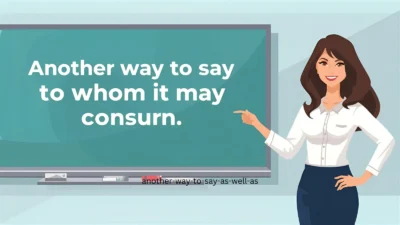The word “also” is one of the most common ways to add information or connect ideas. While it works well in most situations, overusing it can make writing repetitive or sound too simple. Depending on the context, you may want a formal, casual, or creative alternative.
In this article, you’ll find 40 different ways to say “also”, with meanings, explanations, examples, best uses, and tone so you can pick the perfect fit every time.
1. As Well
Meaning: In addition to something else.
Explanation: Common substitute for “also,” especially at the end of sentences.
Example: “She enjoys reading and painting as well.”
Best Use: Everyday speech and writing.
Tone: Neutral, conversational.
2. Too
Meaning: In addition or likewise.
Explanation: Informal and widely used alternative to “also.”
Example: “I’d like some coffee, too.”
Best Use: Casual conversation, informal writing.
Tone: Light, friendly.
3. In Addition
Meaning: Adds more information.
Explanation: Slightly more formal than “also.”
Example: “In addition, the policy will reduce costs.”
Best Use: Essays, reports, professional contexts.
Tone: Formal, polished.
4. Additionally
Meaning: Serves to add another point.
Explanation: Professional alternative; stronger than “also.”
Example: “Additionally, we need to revise the budget.”
Best Use: Academic, professional, business writing.
Tone: Formal, authoritative.
5. As Well As That
Meaning: Adds another idea to the list.
Explanation: Slightly more casual than “in addition.”
Example: “She’s talented at singing, as well as that she can dance.”
Best Use: Informal but structured writing.
Tone: Conversational, polite.
6. Moreover
Meaning: Adds emphasis to a new point.
Explanation: Common in persuasive and academic writing.
Example: “Moreover, this approach saves time.”
Best Use: Essays, arguments, formal writing.
Tone: Formal, persuasive.
7. What’s More
Meaning: Introduces additional, often surprising, information.
Explanation: Informal but adds emphasis.
Example: “The hotel was cheap, and what’s more, it was close to the beach.”
Best Use: Storytelling, blogs, casual persuasion.
Tone: Friendly, engaging.
8. Along with That
Meaning: Something included in addition.
Explanation: Shows connection between items.
Example: “Along with that, we’ll need more resources.”
Best Use: Semi-formal communication.
Tone: Neutral, cooperative.
9. Plus
Meaning: Adds something extra.
Explanation: Casual and simple, often used in conversation.
Example: “It’s affordable, plus it looks great.”
Best Use: Informal speech and writing.
Tone: Casual, light.
10. As Well As
Meaning: Adds one thing to another.
Explanation: Common in both casual and formal use.
Example: “She speaks French as well as Spanish.”
Best Use: General use, versatile.
Tone: Neutral.
11. Together With
Meaning: Added or combined with.
Explanation: Connects items or actions.
Example: “Together with his skills, his attitude makes him stand out.”
Best Use: Formal writing and professional contexts.
Tone: Balanced, professional.
12. Coupled With
Meaning: Combined with another factor.
Explanation: Formal phrasing, often in analytical writing.
Example: “High demand, coupled with low supply, drives prices up.”
Best Use: Business, academic, analytical writing.
Tone: Formal, logical.
13. Likewise
Meaning: In the same way or similarly.
Explanation: Shows similarity or adds to agreement.
Example: “She was impressed; likewise, I found the event inspiring.”
Best Use: Polite conversations, essays.
Tone: Formal, respectful.
14. Furthermore
Meaning: Adds strong emphasis to a new point.
Explanation: More forceful than “also” or “moreover.”
Example: “Furthermore, this method ensures accuracy.”
Best Use: Academic essays, persuasive writing.
Tone: Formal, assertive.
15. On Top of That
Meaning: Adds another noteworthy fact.
Explanation: Casual and emphatic.
Example: “He’s hardworking, and on top of that, he’s reliable.”
Best Use: Casual speech, storytelling.
Tone: Friendly, informal.
16. Into the Bargain
Meaning: Adds something unexpected.
Explanation: More idiomatic and less common.
Example: “She managed the project successfully, and got promoted into the bargain.”
Best Use: Creative or narrative writing.
Tone: Colloquial, expressive.
17. Over and Above That
Meaning: Beyond what’s already mentioned.
Explanation: Formal and emphasizes extra points.
Example: “Over and above that, the team delivered early.”
Best Use: Speeches, professional writing.
Tone: Formal, emphatic.
18. In Like Manner
Meaning: In a similar way.
Explanation: Slightly old-fashioned but still used in academic writing.
Example: “In like manner, the results confirm the hypothesis.”
Best Use: Formal, academic texts.
Tone: Formal, traditional.
19. By the Same Token
Meaning: For the same reason; in a similar way.
Explanation: Links two related points.
Example: “He’s very disciplined; by the same token, he expects discipline from others.”
Best Use: Analytical or logical discussions.
Tone: Formal, thoughtful.
20. With That
Meaning: Adds another point or item.
Explanation: Works well in casual conversation.
Example: “With that, we’ll finish the report.”
Best Use: Semi-formal to casual contexts.
Tone: Neutral, flexible.
21. Equally
Meaning: In the same way.
Explanation: Highlights balance between ideas.
Example: “She is equally skilled in design and coding.”
Best Use: Academic and professional contexts.
Tone: Formal, balanced.
22. Plus the Fact That
Meaning: Adds a point with emphasis.
Explanation: Conversational, stresses significance.
Example: “It’s affordable, plus the fact that it’s eco-friendly.”
Best Use: Informal speech and writing.
Tone: Casual, engaging.
23. Side by Side With
Meaning: Together or along with something.
Explanation: Highlights parallel contributions.
Example: “Side by side with his studies, he works part-time.”
Best Use: Formal and descriptive contexts.
Tone: Balanced, descriptive.
24. Not Only That
Meaning: Introduces an additional strong point.
Explanation: Adds emphasis and surprise.
Example: “Not only that, but the app is free.”
Best Use: Persuasive speech, marketing, casual writing.
Tone: Engaging, persuasive.
25. Hand in Hand With
Meaning: Occurring together with something.
Explanation: Common for describing harmony or cooperation.
Example: “Innovation goes hand in hand with risk.”
Best Use: Business, academic, creative writing.
Tone: Neutral, professional.
Conclusion
The word “also” is versatile but can become repetitive. By using alternatives like “moreover,” “furthermore,” and “additionally” in formal writing, or “plus,” “too,” and “on top of that” in casual speech, you can keep your communication clear and engaging. Choosing the right synonym helps you match tone, context, and audience.



